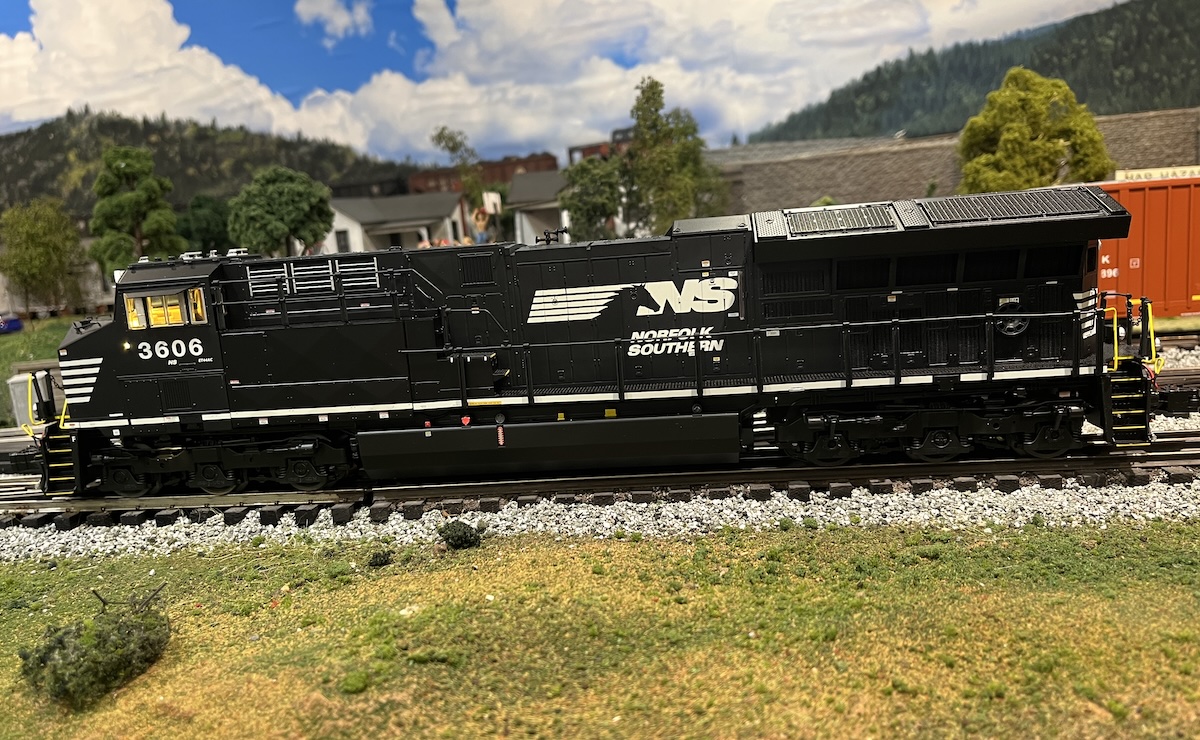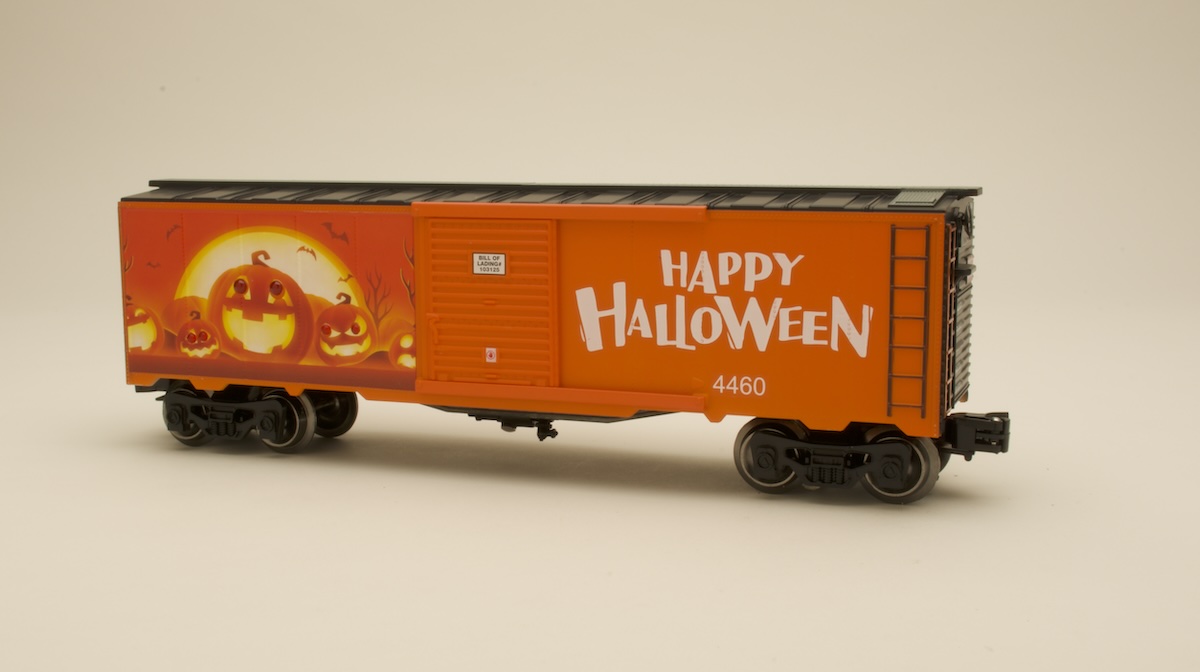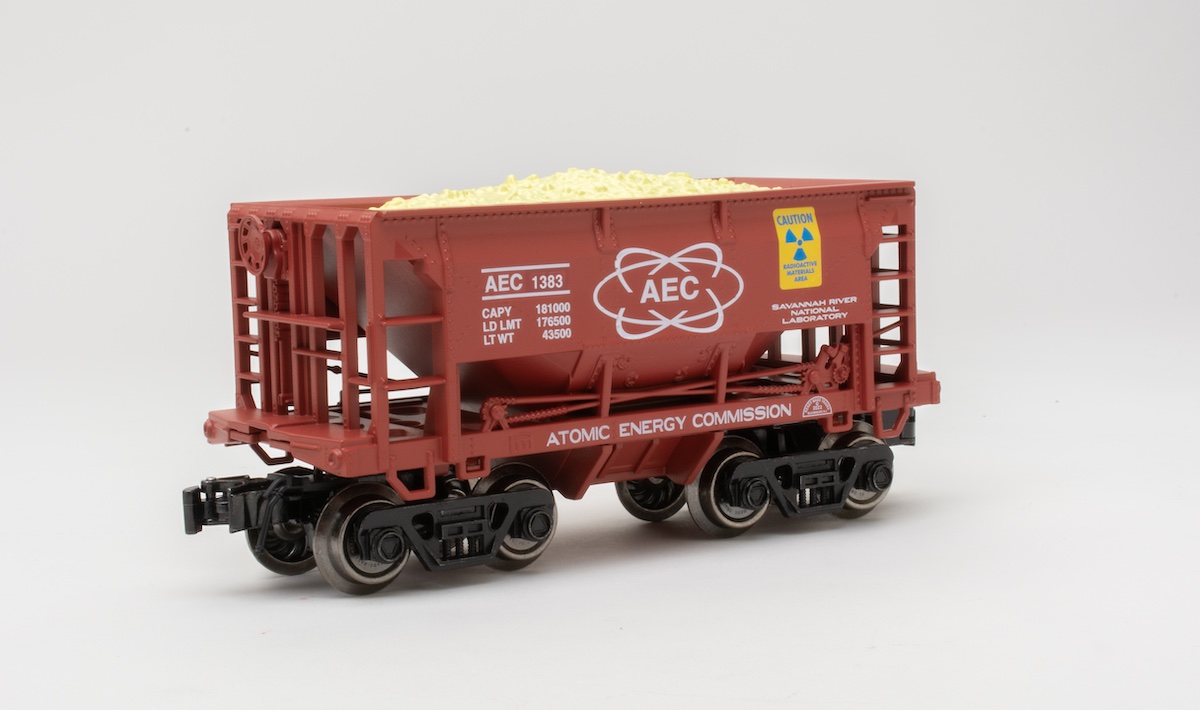The RS-3 has been popular in O gauge. Weaver, Lionel, and now K-Line and MTH offer models in O gauge. American Models offers one in S gauge.
The two models before us take differing approaches to re-creating this engine: K-Line’s is listed as a O scale model, and the MTH locomotive is listed as a semi-scale version incorporated in its RailKing line.
K-Line’s version
This is an attractive model that captures the look of the prototype well.
The coupler-to-coupler length of the RS-3 is 143/4 inches long and it stands 4 inches tall, which in O scale is 59 feet long and 16 feet tall. The actual RS-3 is 55 feet long and 141/2 feet tall. The model’s difference is mainly due to coupler size.
The tooling is clean and smooth, and offers a fair amount of louver, hatch, and latch detail. Add-on items include grab irons and a simulated horn mounted on the cab roof. There’s a drop bridge on each deck platform, and the decks themselves wear a safety diamond pattern.
At the end of the long snout, you’ll find a see-through grill with a fan blade beneath. The exhaust stack is also an add-on detail. We managed to knock it off during normal handling, but it was easily re-glued to the shell.
The cab has two crew figures, both facing the short hood. The side windows have two panes of clear plastic and are “open.” A rain shield is placed above each window. Front and rear windows have add-on wiper blades. Beyond the crew figures the cab is empty – some models have a cab filled by a motor, others the continuation of the plastic that forms the sides of the engine hood.
The K-Line RS-3 uses a sheet-metal frame atop die-cast metal trucks and couplers. The fuel tank (housing the engine’s speaker) is also die-cast metal. An unexpected surprise is the metal air brake hose extending from the truck. Though it’s made of metal, we still managed to snap one off in a messy derailment on our test layout.
The only visual aspect of the RS-3 that I find distracting is a gap between the frame and the trucks. As the photos illustrate, this is easy to spot if you drop your line of sight down to track level. If this is likely to bug you, just don’t kneel down or bend over to track level to watch the train roll past!
The New York Central lightning stripe paint scheme is well executed, and the black and white safety stripes on the front of the trucks (behind the couplers) are extremely attractive.
One minor nit to pick regarding the decoration is that K-Line painted the handrails on each end yellow, but left those running the length of the body black. Most of the color photos I’ve seen of New York Central diesels show all of the handrails painted yellow.
K-Line is producing a nice variety of RS-3 road names, including Circus Transport, Cotton Belt, Long Island, New York Central, Pennsylvania, Reading, Rock Island, and Southern Pacific.
On the test track
K-Line’s RS-3 performed admirably on our test track, with a low-speed average of 19.3 scale mph and a high-end average of 128.1 scale mph. The 4-pound, 4-ounce locomotive has a drawbar pull of 1 pound, 8 ounces, equal to 72 modern, free-rolling freight cars on straight and level track. With a 25-car mixed make and vintage freight train in tow, the RS-3 averaged 104 scale mph.
The RS-3 has two pickup rollers (one on each truck) spaced 8 inches apart, and we didn’t experience any stalling during our slow-speed switch track test. The only quirk we noted was that the couplers tended to pop open quite a bit, so out came the rubber bands!
The RailSounds suite was excellent, and the TrainMaster system performed as advertised. There were no quirks when operating with the MRC DualPower O-27 transformer.
The bottom line? The K-Line RS-3 is a pleasing engine that is a capable cargo hauler with plenty of body detail.
The RailKing RS-3
As with RailKing steamers, RailKing diesels are representations of the real thing more than they are scale models. Within the RailKing diesel community there are some wild variations in size.
For example, my Dash 8 40B is 141/2 inches long or 58 feet in O scale, and the RS-3 is 14 inches long or 56 feet in scale (which is on target for an O scale model). In the real world, however, the Dash 8 is 11 feet longer than an RS-3.
As with all the RailKing diesels, the RS-3 has a high number of reference points represented in the shell, including vents, hinges, and handles. All vents and radiators are solid. Add-ons are few, but include brake wheels and horns on either side of the cab, as well as metal handrails.
The appearance of the complex Rock Island red, white, and black paint scheme is superb. The ends of the handrails and grab irons near the steps are painted white, as are the edges of the steps. There are also black and white safety stripes along the sides of the engine at deck level.
MTH has cataloged this engine in several road names, and I’ll bet the RS-3 will become a staple of the RailKing line. Railroads included in the list are Amtrak, Boston & Maine, Erie-Lackawanna, Great American Circus, Lehigh Valley, New York Central, Pennsylvania, Reading, Rock Island, Seaboard, Union Pacific, and Western Maryland.
The locomotive has a stamped steel frame and a heavy die-cast metal fuel tank that also houses the engine’s speaker. The gap between the diesel’s frame and the trucks is far less noticeable than that on the K-Line model.
The only truly “low bidder” element of the RS-3 is that the cab is simply slipped over the main shell.
If you peer through the windows you’ll see the red and black Rock Island stripes running through the cab. I can live without crew figures, but if that section had simply been painted all black, the “slip-it-over” nature of the cab would have made this economy less obvious.
On the test track
The RailKing RS-3, with its ProtoSpeed cruise-control electronics turned on, performed quite well. Low-speed average was a mere 6.9 scale mph, and the high-end average was 101 scale mph. We measured the drawbar pull of the 4-pound, 12-ounce locomotive at 1 pound, 15 ounces, equal to roughly 93 modern, free-rolling freight cars on straight and level track. With a 25-car mixed make and vintage train in tow, the RS-3 averaged 76 scale mph.
The engine has two pickup rollers positioned 71/2 inches apart, and we noted no connectivity trouble. Most railroads ran their RS-3s long hood forward, and the RailKing RS-3 operates in the same manner.
The ProtoSound 2.0 system offers some very appealing Alco diesel rumblings. Other conventional-mode commands, such as coil coupler activation, worked as advertised, although accessing them with a Lionel CAB 1 controller was an exercise in frustration.
The CAB 1 horn and whistle signals generally are too long in duration to trigger the ProtoSound 2.0 features, no matter how quickly you tap the buttons. Instead of opening the rear coupler – the command is one bell and three whistles/horns – I usually beeped the horn or turned on the bell.
The RS-3 also comes in a LocoSound version. We were only able to test the engine in the conventional mode since controllers for MTH’s Digital Control System were not yet on the market.
The ProtoSound 2.0 version of the RS-3, like most other MTH ProtoSound 2.0 power we’ve tested, won’t work properly with the MRC DualPower O-27 transformer.
The MTH RS-3 may be slightly less detailed than the K-Line RS-3, but it still delivers good, all-around performance at an attractive price.















The old Weaver RS-3 with the solid pilots (yes, solid in 3 rail) and the chain drive were fantastic bargains and immensely more detailed than these. I have at least 5 and they run and look great.